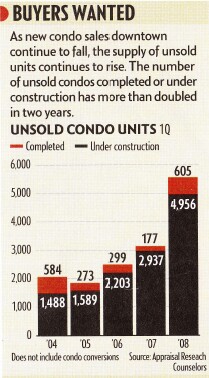Anyone who has looked around Chicago during the last year has probably remarked to themselves that there sure are a lot of cranes in the air building ever more expensive condominiums. The Chicago Spire alone is adding 1194 units to the supply and constructing a building that tall can not be cheap. I for one don’t know where the developers plan on getting the buyers, and especially at the prices I’m seeing. In the South Loop area alone the MLS currently has 1,116 condominiums on the market, 390 of which are over $500,000 with $400+/month assessments plus taxes.
Well, this last week Crain’s Chicago Business ran on article on the Downtown Dead Zone, highlighting the woes of condominium developers. Here are some of the highlights (or lowlights) of the article:
- In the first quarter of 2008 downtown developer condo sales were down 83% from the previous year to only 201 units. This gives new meaning to the word downtown.
- 2007 developer sales were down 54% from the peak in 2005.
- The glut of condos on the market is causing some development projects to be put on hold and other projects are converting to apartment buildings.
Crain’s also supplied this graphic that succinctly summarizes the situation.
As buyer’s consider purchasing into these developments they have to be nervous. What would happen if the developer is left holding a large portion of the building? What if the developer starts to heavily discount the selling prices after the majority of the units have been sold at “list price”? And does the developer have the financial wherewithal to keep the association afloat with only a portion of the units contributing to the funds?
We may soon find out the answer to these questions.